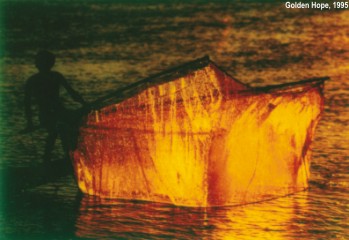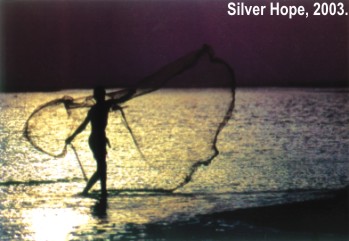Exhibition STRIVING FOR HARMONY
An exhibition by Noazesh Ahmed showcases his work of last 48 years
Mustafa Zaman
 How do you reconcile the scientifically inclined eye with that of the artistic one? Aren't they far apart? Plant geneticist and photographer Noazesh Ahmed's efforts render these questions irrelevant. He says, " There is no conflict between the two worlds; what I observe through the microscope is similar to what I confront in reality." A photographer who is constantly discovering the formal beauty of nature in his works and who seeks out textures, patterns and colours in every subject he confronts has only brought to light that fertile ground where the two worlds, one of photography another of science, coalesce. How do you reconcile the scientifically inclined eye with that of the artistic one? Aren't they far apart? Plant geneticist and photographer Noazesh Ahmed's efforts render these questions irrelevant. He says, " There is no conflict between the two worlds; what I observe through the microscope is similar to what I confront in reality." A photographer who is constantly discovering the formal beauty of nature in his works and who seeks out textures, patterns and colours in every subject he confronts has only brought to light that fertile ground where the two worlds, one of photography another of science, coalesce.
Noazesh's recent show at the Bengal Gallery of Fine Arts is aptly titled, "Quest for Harmony." The man strives to bring to the fore the beauty in everything. "Harmony of colour and form is what I call beauty," he says, and each of his works stands proof of this conviction.
His last show, in his own words, was based on the concept of quest for reality. And after the surrounding realities have been properly interiorised, the time comes for any one to make sense of all that one captured. Hence the need for the present show, which is about taking stock of what transpired all these years. It is a retrospective of sorts, though the photographer himself is unwilling to call it that.
In this show the 70-year-old photographer agglomerated most of his outstanding achievements. From the first photograph to the works done in recent years, it charts his assent to the present status. All that is representative of Noazesh Ahmed is brought together in one show. It provides an opportunity to gaze at the nuggets that make up Noazesh's oeuvre.
 Noazesh was a student of class eight when he first picked up a camera to capture the human environment. "The year was 1947, and I was given a camera by one of my older brothers. It was a Baby Brownie camera, and since the first attempts I did not stop," says Noazesh. For the first snap of goon-tana (tugging of boats), young Noazesh had to wait for days. "I waited for the cloud formation that you see in the picture, and to make the white clouds stand out I resorted to improvisation, I used a cellophane paper as a substitute for a filter," he relates. Noazesh was a student of class eight when he first picked up a camera to capture the human environment. "The year was 1947, and I was given a camera by one of my older brothers. It was a Baby Brownie camera, and since the first attempts I did not stop," says Noazesh. For the first snap of goon-tana (tugging of boats), young Noazesh had to wait for days. "I waited for the cloud formation that you see in the picture, and to make the white clouds stand out I resorted to improvisation, I used a cellophane paper as a substitute for a filter," he relates.
Though young Noazesh had felt a strong passion for continuing his efforts in capturing the reality, it was during his study in America that he struck gold. He, during the early 1950s, came to the realisation that though his endeavour to be a scientist was sure to become a reality, his artistic inclination too was to take him to the height of fulfillment. "At the University of the Wisconsin, in 1957, Prof Lederberg, who later won the Nobel prize for his DNA/RNA research, stumbled upon my works that were on display at an exhibition, and said, 'You have a very special inner eye. Don't lose it, wherever you are -- you may be a professor or a research scientist -- keep it alive,'" Noazesh relates. And he took his teacher's word to heart and kept the passion alive.
In America, there was another event that had a deciding effect on young Noazesh. "In around 1957, I was among the two foreigners who participated in a show called 'Portrait of America'. Among other participants were the American icons like Ansel Adams, Edward Weston, Gordon Parks and Ernest Hass," he points out.
The show travelled across the breadth of America and around the world. The very thought that his works would be on display in the major galleries and museums filled young Noazesh, a science student getting his PhD, with an overwhelming confidence. After completing his study in America he subsequently served as the head of the Agro-botany Division of Pakinstan Tea Research Institution, as a member secretary of Pakistan Tea Board, and as senior staff consultant of Asian Development Bank, World Bank and FAO, but he never gave up his habit of snapping beautiful pictures.
 During his study he was exposed to Renoir and Picasso. "It was Renoir with his sensitive handling of light and colour who remains forever a source of inspiration," says Noazesh. He was attracted to the works of Gordon Parks and Ernest Hass, the latter for his innovation in panning the camera to capture moving subjects. The exposure to the work of the giants of photography as well as to art stimulated Noazesh and made him what he is today. During his study he was exposed to Renoir and Picasso. "It was Renoir with his sensitive handling of light and colour who remains forever a source of inspiration," says Noazesh. He was attracted to the works of Gordon Parks and Ernest Hass, the latter for his innovation in panning the camera to capture moving subjects. The exposure to the work of the giants of photography as well as to art stimulated Noazesh and made him what he is today.
Seen from a political perspective, most of signature Noazesh photographs look pretty and innocuous, yet his involvement with the independence movement in 1971 had earned him the wrath of the Pakistani authorities. "I, along with Mostofa Monwar, was involved in a programme televised on March 21, 1971, that expressed a pro-independence attitude and as its repercussion the Pak army started looking for us. They succeeded in wiping out all my photographs and negatives in my house while I was in hiding. All my works of the pre-independence period were destroyed," laments Noazesh.
For today's young photographers, Noazesh has only one thing to say: "They should concentrate on the excellence of their work, but instead they are bent on winning awards in international competitions." As a photographer who avoids being in the rat race, Noazesh religiously avoids the competitions. When he finds himself on the hot seat of the jury at international competitions, he looks for authenticity and "the emotional attachment to one's subject as well as technical perfection." He admires the work of Amanul Haq, Naimuddin, Nasir Ali Mamun and Anwar Hossain. As for his own future course, Noazesh wants to explore the possibilities of dancing reflection of two figures in the works titled "Brother and Sister". "I want to draw from the idea of dance," he says, and they will capture the rhythm of human figures.
Copyright
(R) thedailystar.net 2005 |
